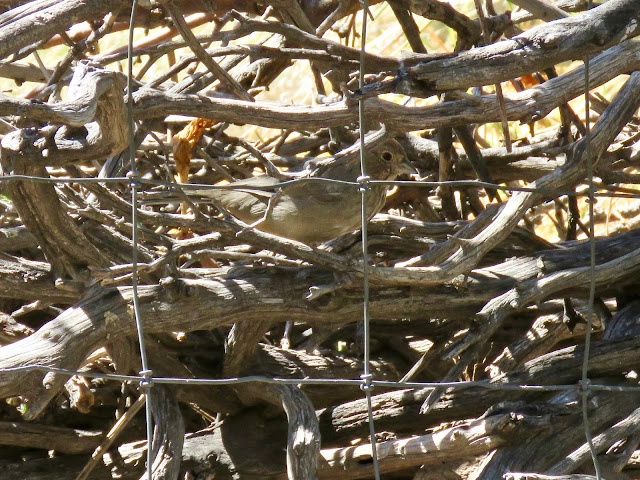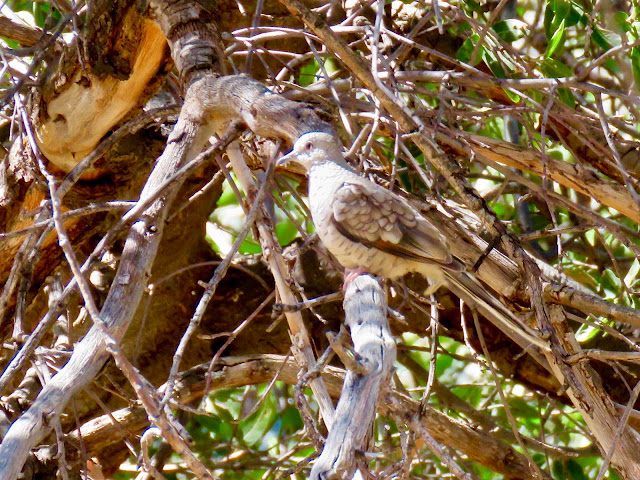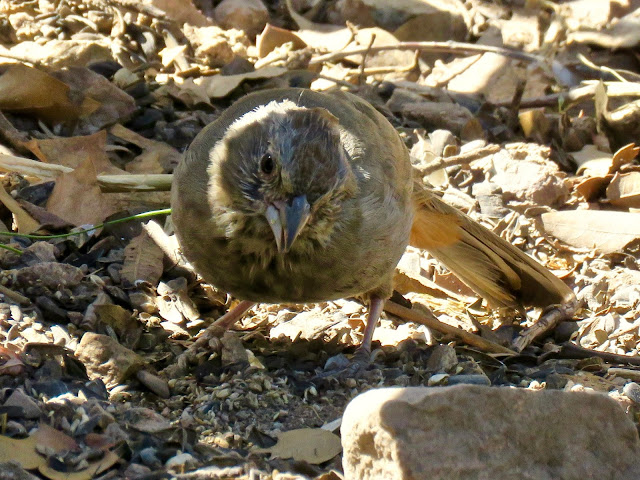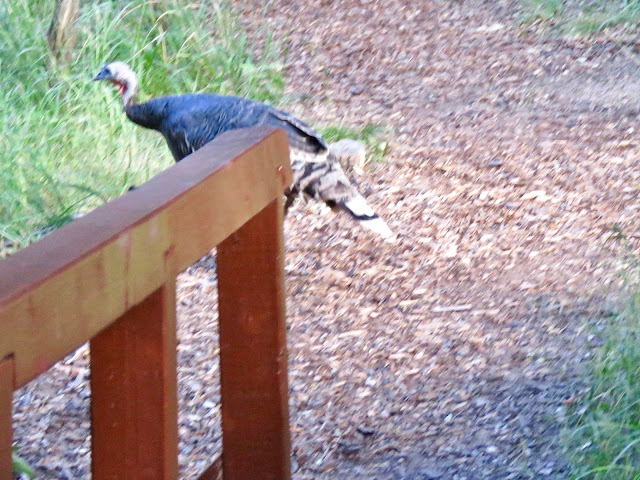Day #1 Saturday, September 23, 2017
We departed the East Valley of Phoenix early enough to get a decent start on the birding trails at the San Pedro House in Sierra Vista. (8:25 a.m.)
As Kathleen McCoy, Hinde Silver and I reached the San Pedro River trail, the local birding group caught up to us so we stayed with them for awhile. Adding so many more eyes to the field, trail, river and cottonwood trees had us swinging our binoculars first one way and then the other as someone would call out a sighting. “ORANGE-CROWNED WARBLER in the short mesquite.” “LAZULI BUNTING at river’s edge taking a bath.” “BLUE GROSBEAK.” And, on and on it joyfully went.
 |
| Young LAZULI BUNTING at San Pedro River |
 |
| Adult male LAZULI BUNTING [from my files] |
 |
| BLUE GROSBEAK |
I was a bit disappointed that we had turned toward the bridge. My target bird was upstream (San Pedro flows North to South; Mexico mountains to Winkleman where it flows into the Gila River.) But I, too, follow the birds and they were all around us. Eventually, a man noted that time was elapsing and he wanted to see the LOUISIANA WATERTHRUSH, also my target bird. A few of us split from the main group to follow this man upstream.
Just as I heard the bird’s first definitive “chip”, Richard one of the group leaders arrived and spotted our target bird but it flew off. He followed the bird upstream, as did we. I began to hear the “chip” repeatedly and finally Richard stopped with the bird showing beautifully on a downward bending peeled thick limb close to the water across the narrow river. At a distance of about 20 feet downstream from the bird, I still had my clearest view ever of a LOUISIANA WATERTHRUSH! And, then! It was gone.
Again, I heard the chip so I stayed still. Soon, the bird popped out into clear view on a big fallen log on the opposite bank directly in front of three of us. So in awe of my sighting, I was too slow with the camera.
 |
| LOUISIANA WATERTHRUSH [Internet Photo] |
While Hinde, Kathleen and I headed further along the river trail toward Kingfisher Pond, the main bird-walk group went elsewhere. Soon, though, Judy from Tucson Audubon caught up and joined us. She had been with Hinde and me when the LOUISIANA WATERTHRUSH showed itself directly across the San Pedro River from us!
Not a single duck paddled on Kingfisher Pond. But lots of other birds got our immediate attention. Two GRAY HAWKs calling to one another intrigued us. But then we got distracted with the whinny of a SORA (chicken-like marsh bird) and the sight of a male COMMON YELLOWTHROAT.
 |
| SORA [file photo] |
 |
| COMMON YELLOWTHROAT [file photo] |
We had moved closer to the GRAY HAWKS so their calls seemed less conversational. “PEOPLE! PEOPLE! PEOPLE!” A screaming quality had entered their whistling communication.
We searched the trees for them. Finally, I just laughed. I said, “I’m looking at a pair of yellow feet and legs but the rest of the hawk is behind a thick limb.” As they searched for the bird, it lifted off and flew over us. It was an adult with light gray short wide underwings and boldly banded black and white tail showing very clearly under the darkish cloud above us.
The second hawk took off from its perch to follow the adult. It flew directly past us! I gasped; it looked like a Northern Goshawk face! But the body was not that bird. This was a juvenile GRAY HAWK with a tail as long as a Cooper’s Hawk with many thin bands across it. Its white rump is actually the first band on the top of that tail (as also on the adult where it appears to be part of the rest of its black and white barred tail).
 |
| Adult GRAY HAWK [my photo files] |
 |
| Juvenile GRAY HAWK [Internet Photo} showing its brown back, spotted chest & belly and white cheek |
We enjoyed more birds in the trees around the pond: WILSON'S WARBLER, YELLOW-RUMPED (Audubon's) WARBLER, LINCOLN'S SPARROW and BROWN-CRESTED FLYCATCHER.
What a morning it had been! We wished Judy the best on her return to Tucson as we moved up the highway (Rt. 90) a bit toward town. At midday, we stopped at the EOP (Environmental Operation Project) where viewers stand on a platform to view the wastewater treatment plant ponds. Reeds were so high, no water was obvious. The only ducks that lifted and flew back and forth were MALLARDs. A GREAT EGRET did show itself and several kingbirds (both WESTERN and CASSIN'S) were flycatching over the grassy area below the deck. We ate our lunch there.
By 1:00 p.m., we had reached Mary Jo's Ash Canyon B&B where her side yard full of feeders was being inundated with so many varieties of hummingbirds, I didn't sit down for half an hour until I got a handle on the many species.
 |
| Mary Jo's side yard with hummers buzzing around all the feeders |
 |
| Water feature in backyard of Ash Canyon B&B with lilies blooming |
 |
| ANNA'S HUMMINGBIRD (male) |
 |
| CANYON TOWHEE (above and below) |
 |
| INCA DOVE |
 |
| BEWICK'S WREN |
Obviously, I was seated poorly to get a clear photo of the RIVOLI HUMMINGBIRD (formerly MAGNIFICENT) but did catch a female RUFOUS HUMMINGBIRD in the process. Note the significant difference in size!
Always looking for the greatest rarity at any birding spot, we did see the continuing rare southern species, LUCIFER HUMMINGBIRD, but I got no photos.
 |
| RIVOLI'S HUMMINGBIRD showing its magnificent colors |
After two hours there, we moved on to Ramsey Canyon. Birds were unbelievably quiet. During the hour it took us to walk up the canyon, around Bledsoe Loop and back, we managed to collect all of five (5) species.
 |
| L-R: Kathleen and Hinde at the old chimney |
Most exciting were the thirty-one (31) WILD TURKEYs.
 |
| WILD TURKEY (above and below) |
 |
| Coues' White-tailed Deer (buck) |
The Coues' White-tailed Deer and a White-nosed Coatimundi were the other highlights so we didn't leave disappointed.
We pulled into Brown Canyon Ranch on our way out from Ramsey Canyon where we picked up a few more interesting birds before heading out for a bite to eat.
Day 2 Sunday, September 24, 2017
The first stop on my agenda for today was a canyon I love but hadn't visited for over two years. It's on Fort Huachuca. Security was tightened at the Army Base then and we could no longer just show our Arizona driver's license to enter. The Base relocated its entryway and required all visitors to stop and fill out a form to gain entrance. Although other birders assured me it was no big deal, I had procrastinated until now. Today, we would go on the base and up Huachuca Canyon.
The Visitor's Entrance Center was small but efficient and we were the only ones present at 8:00 a.m. this Sunday morning. After filling out a form, the guard took our photo and then, surprisingly, gave us a pass for one year's entrance. Yay!
With only the entrance road changed, it was easy to find my way through the Army Base to the canyon road. But what a road! Once again, my Honda Insight became the jeep of the day as it found a line between rocks to make it all the way to the "parking lot".
Having never birded Huachuca Canyon in September, I was surprised to find so few birds. I'll assume the recent post in eBird was done by ear since the number of physical birds in our presence seemed slim.
After 0.8 miles up the Canyon, we decided to work our way back (1.6 miles total) and discovered we had seen some very good birds - just not gobs of any one species. Except for WILD TURKEYS @14.
ACORN WOODPECKERs, NORTHERN RED-SHAFTED FLICKERs and MEXICAN JAYs were fairly common back and forth over the trail. But we spotted only One (1) BAND-TAILED PIGEON (a forest pigeon).
Butterflies and dragonflies were everywhere. Many times we lifted our binoculars to the movement of these insects thinking they were birds!
I heard tanagers several times and we came up with a single SUMMER TANAGER (male) and two WESTERN TANAGER (male and female).
Kathleen had never seen a PAINTED REDSTART and was thrilled with seeing that colorful bird.
We saw several warblers and a small flock of bushtits, but our best sighting for me was the INDIGO BUNTING.
With the rough road (heavy rains and washouts), the drive back down to civilization (the Army Base) took almost as long as going up. When we were far up on the trail, a man with his daughter asked if we (all women) were the ones that came up in that little car. Yes!
He just smiled and shook his head.
Since Huachuca Canyon was my only plan for the day, I improvised for a stop on the way back home. I wanted to check out El Rio Open Space in north Tucson to see if it would be worth a stop when I next visit some birding spots in Tucson. We spent twenty (20) minutes there but with no water at all in the depression that holds overflow from the Santa Cruz River, no waterfowl were present.
So, we continued west on I-10 toward Phoenix. As we neared Red Rock exit, I explained that on my last several runs to Santa Cruz Flats, I hadn't visited the Feed Lots. They may stink but birds are plentiful. With two fairly new birders in the car, I thought I might be able to share one of my favorites with them. Lark Buntings are often in the grasses across the narrow paved road from the feedlots. But the desert was bare; no grass at all; and no Lark Buntings.
So we contented ourselves with birding out the car window with binoculars trained on the mesquite trees in front of the feedlot fence. If I shook just one tree, at least 10 MORNING DOVES, 35 RED-WINGED BLACKBIRDS, a half dozen GREAT-TAILED GRACKLE and 10 BROWN-HEADED COWBIRDS would fall out. Within that dense gathering of birds were some small birds, so I focused on them. What I saw took my breath! I was looking at a female DICKCISSEL. I recalled that other birders were seeing them migrating through so I didn't discount my sighting but looked at all the details -- that added up to exactly what I had called. Unfortunately, my camera was in the trunk for the ride home. But, I had no question about that bird and I was thrilled!
You can check out all our bird lists by clicking on the links below.
75 species from 8 locations.
We were surprised at the mild temperatures upon our return to Tempe and home (85°F).
Our adventurous weekend had been superb!
The Visitor's Entrance Center was small but efficient and we were the only ones present at 8:00 a.m. this Sunday morning. After filling out a form, the guard took our photo and then, surprisingly, gave us a pass for one year's entrance. Yay!
With only the entrance road changed, it was easy to find my way through the Army Base to the canyon road. But what a road! Once again, my Honda Insight became the jeep of the day as it found a line between rocks to make it all the way to the "parking lot".
Having never birded Huachuca Canyon in September, I was surprised to find so few birds. I'll assume the recent post in eBird was done by ear since the number of physical birds in our presence seemed slim.
After 0.8 miles up the Canyon, we decided to work our way back (1.6 miles total) and discovered we had seen some very good birds - just not gobs of any one species. Except for WILD TURKEYS @14.
ACORN WOODPECKERs, NORTHERN RED-SHAFTED FLICKERs and MEXICAN JAYs were fairly common back and forth over the trail. But we spotted only One (1) BAND-TAILED PIGEON (a forest pigeon).
Butterflies and dragonflies were everywhere. Many times we lifted our binoculars to the movement of these insects thinking they were birds!
 |
| Eastern Tiger Swallowtail (that's the name I located on the internet) |
 |
| Unsure. Perhaps a Sootywing? Help appreciated. |
Kathleen had never seen a PAINTED REDSTART and was thrilled with seeing that colorful bird.
 |
| PAINTED REDSTART [file photo] |
 |
| INDIGO BUNTING [file photo provided by Mark Moore when I visited my sister in Western Pennsylvania a few years ago.] |
He just smiled and shook his head.
Since Huachuca Canyon was my only plan for the day, I improvised for a stop on the way back home. I wanted to check out El Rio Open Space in north Tucson to see if it would be worth a stop when I next visit some birding spots in Tucson. We spent twenty (20) minutes there but with no water at all in the depression that holds overflow from the Santa Cruz River, no waterfowl were present.
So, we continued west on I-10 toward Phoenix. As we neared Red Rock exit, I explained that on my last several runs to Santa Cruz Flats, I hadn't visited the Feed Lots. They may stink but birds are plentiful. With two fairly new birders in the car, I thought I might be able to share one of my favorites with them. Lark Buntings are often in the grasses across the narrow paved road from the feedlots. But the desert was bare; no grass at all; and no Lark Buntings.
So we contented ourselves with birding out the car window with binoculars trained on the mesquite trees in front of the feedlot fence. If I shook just one tree, at least 10 MORNING DOVES, 35 RED-WINGED BLACKBIRDS, a half dozen GREAT-TAILED GRACKLE and 10 BROWN-HEADED COWBIRDS would fall out. Within that dense gathering of birds were some small birds, so I focused on them. What I saw took my breath! I was looking at a female DICKCISSEL. I recalled that other birders were seeing them migrating through so I didn't discount my sighting but looked at all the details -- that added up to exactly what I had called. Unfortunately, my camera was in the trunk for the ride home. But, I had no question about that bird and I was thrilled!
You can check out all our bird lists by clicking on the links below.
75 species from 8 locations.
We were surprised at the mild temperatures upon our return to Tempe and home (85°F).
Our adventurous weekend had been superb!
* * *
View this checklist online at http://ebird.org/ebird/view/checklist/S39376063
View this checklist online at http://ebird.org/ebird/view/checklist/S39381567
View this checklist online at http://ebird.org/ebird/view/checklist/S39382312
View this checklist online at http://ebird.org/ebird/view/checklist/S39382742
View this checklist online at http://ebird.org/ebird/view/checklist/S39383207
View this checklist online at http://ebird.org/ebird/view/checklist/S39383617
View this checklist online at http://ebird.org/ebird/view/checklist/S39383763
View this checklist online at http://ebird.org/ebird/view/checklist/S39384027







































